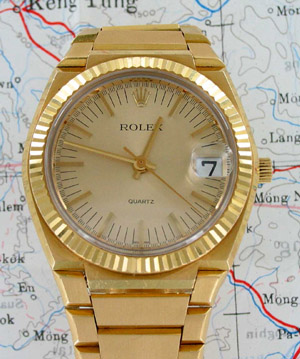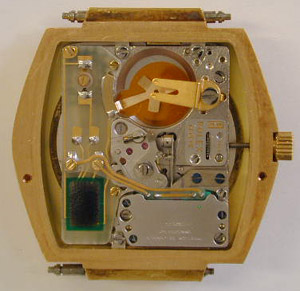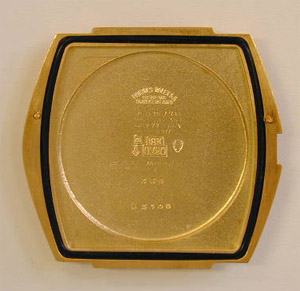|
In 1968 an industrial consortium of Swiss watch manufacturers was created to mass produce the Beta 21. This was a true collaborative effort among otherwise competing watch companies, all of whom would be using the Beta 21 in their own branded quartz watches. The CEH itself designed the module and produced the integrated circuit. Ebauches SA (the forerunner of today's ETA) manufactured the mechanical parts of the movement as well as the quartz oscillator. Omega was responsible for producing the micromotor that powered the watch hands. This "motor" was really a vibrating unit that drove a tiny horizontal pendulum set to oscillate at 256Hz and this pendulum drove the hands by means of a ratchet and index wheel. (This drive mechanism was virtually identical to that used on the original Bulova Acutron.) The end result was that unlike with modern quartz movements, the second hand of a Beta 21 watch moved around the dial smoothly—even more smoothly than the highest "hi-beat" mechanical watch of the time. Final assembly of Beta 21 movements took place in three different manufacturing facilities, with very limited modifications to the movements being made depending on a brand's specifications. Sixteen different Swiss watch companies began selling Beta 21 quartz watches under their individual brand names in 1970, including Rolex with the Quartz Date 5100.
From an esthetic standpoint the 5100 was a styling triumph, with a clean, modern design that utilized an integrated case and bracelet crafted entirely from 18K gold (about 25% were made in white gold). The crystal on the 5100 was synthetic sapphire, a first for Rolex. Clearly this was a very unique watch for Rolex, and they focused heavily on its exclusivity and limited production in their promotional materials:
Despite Rolex's own high praise for the 5100, this watch was an anomaly for the company. Because they had to work with an existing movement, and only limited modifications could be made to it, Rolex essentially had to design the Quartz Date around the the Beta 21 module. This meant that the Oyster case (upon which Rolex had built their reputation for the past forty years) could not be used and the 5100 was listed as "water resistant" rather than "waterproof." In addition, the 5100—despite having the Rolex name on the dial—contained a movement that for all intents and purposes was identical to that found in the watches of sixteen other companies. This put Rolex in a rather untenable position, one they had not been in since the early days when J. A. Aegler produced movements for both Rolex and Gruen. For these reasons, one can surmise that Rolex was never completely happy with the 5100 despite the overwhelmingly positive response it received from the watch buying public. Consequently, in 1972 they withdrew from the CEH as well as the Beta 21 consortium and began developing a quartz movement of their own design and the watch that would house it, the Oysterquartz. ________________ References: The
Smithsonian Institution Photo Credits: 5100 with map background:
James Dowling
The entire contents of this website is Copyright © 2005 - 2009 by Gary M. Frazier. All rights reserved. This material may not be published, rewritten, or redistributed in any way. The copyright for photographs used from other websites remains with the respective owners and credit is given where the photographer is known. Questions or comments about this website may be directed to gmf@oysterquartz.net. Please read the FAQ page before e-mailing me your questions. The answer you seek may already be there. Oysterquartz, Datejust, Day-Date, and the Rolex coronet are registered trademarks of Rolex SA and/or Rolex Watch USA, Inc. Oysterquartz.net is not affiliated with the Rolex Watch Company in any way. |

 The
Oysterquartz traces its roots all the way back to 1970 and the very first
quartz watch produced by Rolex, the Ref 5100. This watch was the
fruit of Rolex's participation (along with twenty other Swiss brands) in
the Centre Electronique Horloger, which was founded in 1962 by
several leading Swiss watchmakers to develop an electronic movement for
use in wristwatches. The final result was the Beta 21, a 13 jewel,
8Khz quartz module first seen in prototype form in 1967.
The
Oysterquartz traces its roots all the way back to 1970 and the very first
quartz watch produced by Rolex, the Ref 5100. This watch was the
fruit of Rolex's participation (along with twenty other Swiss brands) in
the Centre Electronique Horloger, which was founded in 1962 by
several leading Swiss watchmakers to develop an electronic movement for
use in wristwatches. The final result was the Beta 21, a 13 jewel,
8Khz quartz module first seen in prototype form in 1967. The
5100 debuted on June 5, 1970 and initial orders far exceeded Rolex's
expectation, with the planned limited run of 1000 watches selling out
before production even began. In the end, all 1000 serially numbered
5100s were sold between 1970 and 1972. Today a 5100 complete with box and
papers is a highly prized collector's piece.
The
5100 debuted on June 5, 1970 and initial orders far exceeded Rolex's
expectation, with the planned limited run of 1000 watches selling out
before production even began. In the end, all 1000 serially numbered
5100s were sold between 1970 and 1972. Today a 5100 complete with box and
papers is a highly prized collector's piece.
